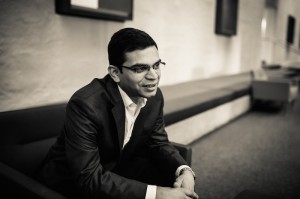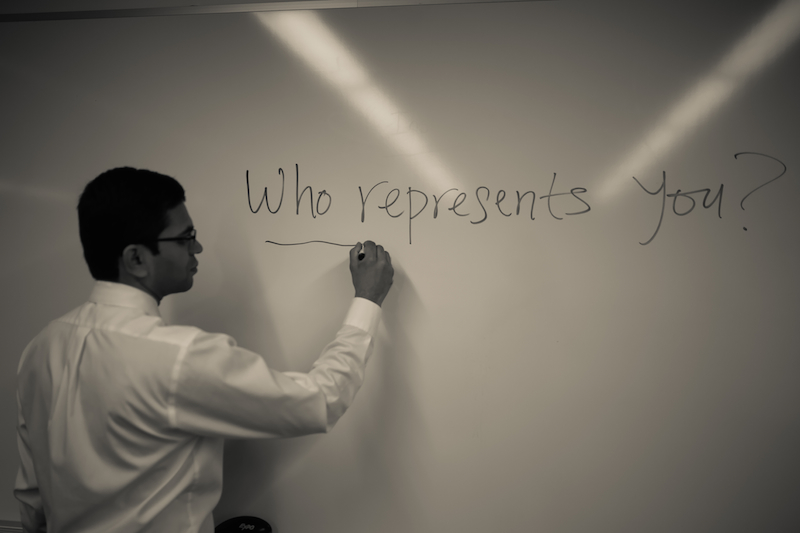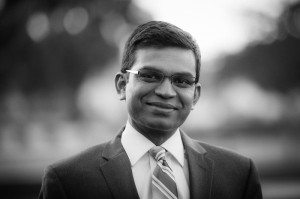The Aerogram does not officially endorse any candidate or organization in connection with this campaign/election. This interview has been condensed and edited for clarity and editorial purposes.
Tackling the nation’s second largest public school district is not an easy feat. In recent months, the Los Angeles Unified School District (LAUSD) has been under a microscope, criticized for its controversial $1 billion iPad initiative, followed by resignations from top administrators, and outrage over unsanitary classroom conditions and the need for immediate school repairs instead of iPads. Most recently, LAUSD agreed to reach one of the largest civil settlements in a sex abuse case that made national headlines.

As LAUSD braces to restore public trust, candidates like 29-year-old Ankur Patel, a native of the San Fernando Valley, is hopeful there will be more transparency and accountability in the education system. According to LA School Report, Patel is the youngest of six candidates running for a seat on LAUSD’s school board.
If elected, Patel would also be the first South Asian to serve on the Los Angeles Board of Education, LAUSD confirmed with The Aerogram. In the past year, three Asian-Americans have served on the board.
Some of the issues Patel hopes to tackle include reducing class size, providing effective teacher evaluations, enhancing the curriculum and instruction time, and diverting attention away from administrators — and instead, focusing more on teachers and students. We spoke with Patel, who formerly ran for Los Angeles city controller and has been regularly involved with the Neighborhood Council system, for more on his campaign promises for school board. The incumbent serving District 3 (covering the San Fernando Valley) is Tamar Galatzan.
Local elections will be held March 3 for various city-wide ballot measures, city council, including the much-anticipated LAUSD School Board election.
What’s your connection to LAUSD? Have you held any previous related positions that inspired you to run for District 3? What sets you apart from other candidates?
I was born in the Northridge Hospital and raised in the San Fernando Valley. My father immigrated from India in 1975 and worked odd jobs while finishing an engineering degree from Cal State University Northridge that helped him get a job as a rocket scientist. My mom immigrated in 1981 and raised me with a focus on getting a good education. I, along with both of my younger brothers, went to LAUSD schools for our entire K-12 education.
I haven’t had any positions with the LAUSD, but I have taught in South Korea, China, and most recently at California State University Northridge. I have also held positions as a Board Member, Treasurer, and Budget Advocate with the Northridge East Neighborhood Council.
What’s at the very core of your campaign, and what are some of the main challenges affecting District 3 that you hope you’ll tackle if elected?
At the very core of my campaign are high expectations for public education. We should have high expectations for our students, the district, and especially for our elected school board members. Wasting money not only on poorly planned large projects (iPad, MiSiS) has become such a regular occurrence that when smaller amounts of money is wasted it is taken for granted. I have heard so many anecdotes from teachers and workers at schools where decision makers have not listened to staff at the school and ended up wasting resources and time for marginal if any benefit for students — the crux here is that decisions are regularly made without taking input from the people who matter.
What do you hope to bring to the plate at LAUSD? LA School Report mentioned that you’re one of the youngest of board challengers.
I hope to bring youthful energy (along with the ability to connect with students), fresh perspective, the ability to mend-broken relationships and build bridges, a thoughtful ear that wants to listen and take input from everyone willing to give it, an independent point of view that is not going to get bogged down in ideology but will focus on the students and the day-to-day of the classroom — I hope to be the kind of elected official and powerful voice that students need.

LAUSD has been in the spotlight for quite some time. Last summer, superintendent John Deasy ditched the $1.3 billion iPad plan which sought to equip every student in LAUSD with iPads. What are some of the lessons that should come out of this failed program? Were you in favor of the launch? What would you have like to have seen done differently?
I oppose the LAUSD’s iPad program. Instead of spending millions of dollars to get electronic devices into the hands of our students, we need to make sure our students can read and do math. But the details of the iPad program, including the misallocation of bond money that was supposed to be used to address the $40 billion in needed construction backlog on our schools, shows that the program was built misallocating funds from the start.
Throughout the program, enough important questions weren’t asked, but when they were, they were not answered. The incumbent, Tamar Galatzan, was the most enthusiastic supporter of the iPad program and also pushed for the removal of Stuart Magruder, a good watch dog, for asking tough questions. Galatzan basically pushed forward the program even though it was not ready, which is still wasting millions of dollars, and then moved to censor criticism of the program.
[Reporter’s note: The Aerogram reached out to Tamar Galatzan for comment via email, but did not receive a response. In May, the Los Angeles Times reported that Galatzan “opposed Magruder because he overstepped his role.” Magruder was a vocal opponent of the iPad program.]
The program’s ongoing costs were not thoroughly, or even briefly, considered; it appears that the program was planned out for only three years. However, there were additional administrative costs including the hiring of 55 instructional support staff to help teachers utilize the iPads. Along with the iPad program, we have to consider the $100 million that was paid for the software, which was not ready and poorly designed as well. The US Department of Education, in January, issued a “damning report” on the management of the program. This is all without even mentioning the FBI the federal grand jury investigation the program.
Technology can be nice and helpful, but the sheer cost paired with the marginal benefit is not fundamental to our children’s education. Also there are much more efficient ways to help students utilize and understand technology, such as supervised computer labs. We have libraries on school campuses that are open for only 3 hours a day, the library can be retrofitted with computers and technology and be turned into a more productive space for a fraction of the cost.
The fact that the iPad program was poorly executed while thoughtful criticism was met with hostility is another reason that this particular program should be rolled back.
In the L.A. City Controller race, you refused to take campaign contributions. Why? And are you taking contributions this time around?
I refused to take campaign contributions because it is the position that is supposed to follow the money. The line I used repeatedly was “corruption has become institutionalized through lobbying and campaign contributions. So I refuse to take any money from anyone.” This campaign, I am taking contributions. As a matter of practicality and running a serious campaign that needs resources to contact likely voters.
What type of experience do you bring to the forefront at LAUSD? Your campaign page notes that you taught English to young children in South Korea. What did you take away from the education system there, and what would you like to see replicated or emulated here?
I bring broad experience with a global perspective on education to the forefront at LAUSD. Even with that, I learned that the day-to-day of the classroom, regardless if the classroom is in Seoul or Los Angeles is centered on the teacher-student relationship. Just as important is the need for students to understand why they are learning and the context of their education — this is what can engage students with their education and commits them to learning. Child-like curiosity needs to be nurtured not taught out of us through rote memorization and standardized tests. Education is often based in cultural values, which means we need broad shifts in the way we view public education in Los Angeles to reach the kind of public education system our young people deserve.
Assemblymember Luis Alejo recently introduced AB 101, a bill that would require the State Board of Education to adopt standards and provide quality courses in ethnic studies. What are your thoughts on the push to enhance and diversify the curriculum at LAUSD?
I support the idea that the diverse history of the world should be represented in our public education system. History is often not taught objectively, and multiple points of view are rarely fairly and equally presented to young people. Again, in a diverse global metropolis like Los Angeles, I think it is important for our youth to know how and why we got to this point — it gives context, purpose, and meaning to their education.
 Some of the issues highlighted in your campaign include reducing class size. What is your ultimate vision for creating a more effective and a long-term sustainable plan that is mutually beneficial for students and teachers?
Some of the issues highlighted in your campaign include reducing class size. What is your ultimate vision for creating a more effective and a long-term sustainable plan that is mutually beneficial for students and teachers?
An effective long-term sustainable plan has to start with the fundamentals of education and the teacher-student relationship.
You recently quoted, “We can’t have 40 students in a class, pay our teachers poorly, and expect good outcomes.” What is the message behind this? And how do you hope to address these issues if elected to School Board?
The message here is that our resources aren’t going to the classroom. Too much money is spent on central district administration — over the last 8 years, the number of students and teachers has decreased, but the numbers of administrators has increased. LAUSD receives over $10,000 per student per year, so in a class of 40 students (the average middle school and high school class size) there should be $400,000 supporting those students’ education.
The fact that we pay our teachers relatively poorly compared to neighboring districts and have larger class sizes drives good teachers out of the district and demoralizes many of the teachers that have my respect for taking on such a difficult job.I think the best way to address the need to refocus resources back into the classroom has to be centered on budget transparency and accountability.
We have to be able to follow the money, and not just a broad “we” — the teachers, parents, and students at a particular school should know how much money is supposed to be getting into their classrooms and then have avenues to follow up and ask questions, get receipts, and hold decision makers accountable.
What are some of the challenges facing District 3?
In this particular district, a more affluent one relative to the rest of the LAUSD, many schools are in a struggle for autonomy — but I think that is a problem that many schools across the district face as the district has a top-down culture. As the district has 360,000 registered voters and 132 campuses with 149 schools — the problems we face are similar to the broader problems in education from overcrowded classes to underpaid teachers who are regularly given new orders to follow that might not be best practices or compatible with their particular students.
Individually, some campuses have had problems with program like breakfast in the classroom, transportation and traffic issues, and the lack of materials in classrooms — but with such a large district spanning so many different communities, the general problems are the same, but individual campuses will have different day-to-day challenges ranging from behavior issues with certain students and not enough counselors or psychiatrists, to bad food in the cafeteria.
In a nutshell, how would you summarize your campaign? It seems like you’re determined to conquer a variety of hard-hitting topics ranging from class size reduction and empowering teachers — what else do you hope to address?
I am running a pragmatic campaign that is focusing on the basics of education and civic participation that can build a strong foundation that can lead to the implementation of big ideas and eventually reimagining public education in Los Angeles.
* * *
Ankur Patel can be reached via Twitter @VotePatel and Facebook.
Monica Luhar is a digital producer and freelance journalist in Los Angeles. Connect with her via Twitter: @monicaluhar.












